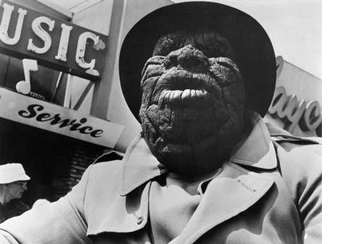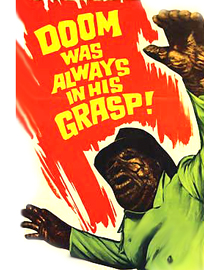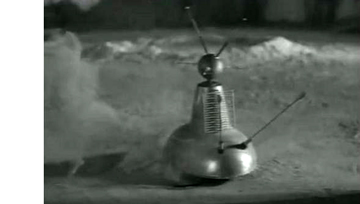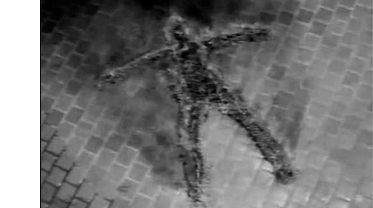
 |
|
|
|
|
20th Century Fox Cinema Archives B&W / 2:35 widescreen / Street Date March 17, 2015 / separate purchases / 19.98 Produced by Robert L. Lippert
I've written before about the merry adventures of Hollywood producer Robert L. Lippert, whose name suddenly disappeared from film credits around 1956 and didn't return for almost a decade. Thanks to the researches of Tom Weaver, we have learned that Lippert got in trouble with the guilds over the issue of residuals. Unable to hire a crew, he entered into what sounds like a pretty slick deal with 20th Fox to quietly produce program pictures on the sly. One of the production companies was called "Associated Producers". Look it up and you'll find quite a few pictures that Fox helped Lippert produce under the table, some under the secondary name "Regalscope". The credited producers on pictures like She Devil, Kronos, The Fly The Return of the Fly, The Alligator People mostly filled in for Lippert, who put the projects together and delivered the final product to Fox. The company provided opportunities for some. Kurt Neumann helped out in the beginning, followed by the prolific director Maury Dexter. Former dancing star Gene Nelson (Oklahoma!) took a fling with Lippert, and began a new directing career that lasted decades.
|
|
Hand of Death was for quite a long time a fairly rare item -- I remember about ten years ago Bill Warren telling me that some fan-friends visiting the ailing John Agar had difficulties finding a reasonable video copy. Genre completists (who, me?) had to content themselves with pretty crummy pan-scanned black market tapes, with a dark image that often obscured the film's photogenic monster, the one that so intrigued us in old stills in Famous Monsters magazine. It was always the same three stills, actually. Until original posters turned up here and there, we weren't altogether sure that the movie was for real. Now, finally seeing the picture in one complete, pristine CinemaScope piece, I have to say... I like it. It seems we'll be referring to Tom Weaver from now on to find out how some of our favorite oddball movies came together. Gene Nelson took his assignment on Hand of Death seriously enough to at least try to give shape to an underdeveloped screenplay. Although his direction doesn't transcend the material, it's professional in all respects. You try to make a movie that has nothing going for it except a rubber mask. This is a good job. 
In a small shack out by Baker, California, Dr. Alex Marsh and grad student Carlos (John Agar & John Alonzo) have figured out a 'kinder & gentler' nerve gas that knocks people out harmlessly, and leaves them susceptible to hypnotic suggestion for days after they wake up. Alex's girlfriend Carol Wilson (Paula Raymond of The Beast from 20,000 Fathoms) doesn't like such sinister weaponry, but both Alex and his sponsor Dr. Ramsey (Roy Gordon) argue that hypno-narcotizing people is better than blowing them up with atom bombs. Neither the ethical discussion nor Carol & Alex's romance progress any further. A few weeks later Alex splashes some experimental compound on himself and becomes a monster. His skin darkens and his touch becomes deadly -- leaving huge black welts on any flesh he comes in contact with. Cast members topple and die in agony. Losing his judgment, Alex goes on the run, killing a cabbie to reach a Malibu beach pad, where a friend may have an antidote serum. Carol's there and would like to help, but the Malibu sheriff isn't far behind. Hand of Death has traditionally been deemed a joke, a non-movie. Back in the '60s it was one of those titles you tuned in at 1:AM when you were out of sleeping pills. It is thin, perfunctory, lacking in any coherent message. What happens to Alex Marsh is just an accident, not a punishment for hubris or making weapons or ignoring one's girl friend. But in widescreen, in good quality, what we see has snap, pace and forward momentum. It's a monster show pared down to its bare generic essentials. Don't get me wrong -- Hand of Death is just as unconsciously absurd as other low-budget films that exploit threatening new technologies for sci-fi thrills. The opening sees Alex and Carlos accidentally zapping the mailman with a dose of nerve gas. They revive him and send him on his way. Sure glad he didn't die, like those sheep from last week! Oh, and get back to us if you have any side effects, Mike. When Alex falls into a trance-sleep after soaking up some of his own nerve medicine, we're treated to a feeble montage of hopping mice and dancing lab glassware superimposed over the unconscious John Agar. Even with the Theremin-driven jazz music score, the scene is pretty silly. 
Hand of Death is a stripped-down cousin of monster movies like The Hideous Sun Demon, First Man Into Space, The Crawling Hand, Man Made Monster and the maladroit Most Dangerous Man Alive. All are about dumbbells transformed via science into grotesque killers. At only 58 minutes, it hasn't time to detour from its bare-bones narrative. Gene Nelson has assembled an okay cast. An older John Agar seems less foolish than he did in his '50s films, and his line readings are more consistent. Considering what he's asked to play, I think Agar does quite well. Paula Raymond actually makes Carol into a reasonable facsimile of a character. Obviously what the film needed was a more developed romantic angle; if only the tentative kind that helps an oldie like WereWolf of London hold together. But Carol's concern is a big help. Alex's monster costume is a sponge rubber mask and hands that will remind many viewers of 'The Thing", one of Marvel Comics' Fantastic Four. The bulbous face looks like a horribly exaggerated allergic reaction. Unfortunately, when Alex dons a trench coat and slouch hat to go running through the streets of Pacific Palisades, he looks pretty funny. He reminds me of Tor Johnson's detective in Plan 9 from Outer Space, if someone had jammed him into a microwave oven. Alex is unable to talk. He can't cope, especially after he accidentally kills people. Ex- stooge Joe Besser's gas station attendant is one of the luckless victims. The Munsters' Butch Patrick has a "Frankenstein vs, little kid" encounter with Alex on the beach. 1Face it: Alex is just a big inconvenience. Looking as he does, he'd probably be shot down even if his touch were harmless. The big rubber guy is doubly superfluous now that matrimony with Carol is out of the question. The movie could have taken its concept in several directions, but it chooses to just wind things up in a big hurry. I wasn't offended -- another ten minutes would likely just add a moral judgment or a religious warning, not some miracle revelation of grace or atonement. Besides, how does a weapons-maker atone for anything? Scientists cooking up nasty biological or chemical agents don't get hurt, people on some other continent do. Tough cookies, Poindexter. 
Angeleno Alert -- some nice locations are on view during Alex Marsh's brief, localized reign of terror. Dr. Ramsey's house appears to be just north of Sunset Blvd. in Pacific Palisades. When Alex snatches the taxi he turns north onto Pacific Coast Highway. He drives under the arch next to Pauliist Productions' cool-looking headquarters (unseen), which was once Thelma Todd's notorious speakeasy. Alex reaches the beach via an unmarked gate between Malibu houses, the kind disguised to discourage beachgoers from using public beaches that the locals would like to consider their private property. The beach house has "X"- shaped supports, but it's not the Malibu Ground Zero House from the end of Kiss Me Deadly. Alex has no superhuman powers, and he isn't a mad killer -- he's just a cocky researcher who becomes fortune's fool. His fate somehow reminds me of the freeway chase dopes that get such good TV coverage in Los Angeles, guys that twenty minutes before may have thought they were minding their own business, just trying to keep rolling for a few more minutes of freedom before spending the next ten years in the penitentiary. Alex is cornered by the cops as well. Maybe if he were given helicopter TV coverage, he'd have had a better chance of surviving the L.A.P.D.. Presentation can make the difference, and seeing Hand of Death in such great shape is all it takes to charm this fan of 'Z' pictures. Floyd Crosby took time off from Roger Corman to shoot this. His CinemaScope images look good indoors -- the sets are pretty dull -- and much better outdoors. Crosby and director Nelson achieve a ninety-second single take shot that tracks the spongy Alex-monster as he runs through two blocks and into a shopping district. Of great help is Sonny Burke's jazzy music score, which pops the film back into gear with every scene change. Heavy with percussive bongos and extended organ notes, it sounds a lot like Howard Shore's score for Ed Wood. I'd previously seen this picture only on a bad VHS, where it seemed on a par with groaners like Beach Girls and the Monster. With this disc I'm boosting it up several notches.
|
|
The Day Mars Invaded Earth has resolute fans among those folk impressed by movies that make more out of less. The ultra- small-scale Martian invasion movie barely meets narrative minimums, yet succeeds in being fairly original, at least on a first viewing. For the early 1960s it's an excellent example of a shrewdly judged no-budget sci-fi programmer. What might have been a good 25-minute Twilight Zone episode is shamelessly padded to feature length... with scenes that make it a cross between Last Year at Marienbad and a Beverly Hills real estate prospectus. 
A NASA The Day Mars Invaded Earth hasn't a great deal going for it. The actors are willing but Maury Dexter's direction is rather pedestrian, failing to inject mystery or urgency into the proceedings, or to smooth out problems in the screenplay. When in doubt, he'll end a shot with a meaningless pan to a statue. But wait -- statues are copies of people, right? Star Kent Taylor still looks good at 55 but seems a little tired; former noir vamp Marie Windsor is at perfect pitch but has been handicapped with a really unflattering wig. 2 The kids are pros. Maury Dexter's direction is rather stiff, possibly because there was no time to finesse anything. Considering the weird things that are happening, David and Claire take things far too calmly. Nobody overplays, at least.
A few minor optical effects help to sell what's going on, but otherwise Harry Spaulding's screenplay is about people talking, broken up with scenes of them walking around a handsome estate in Beverly Hills. 3 It's all very literal, so much so that when the various doubles show up, we're way ahead of the characters. Still, it basically works until David finally comes face-to-face with his personal double. He suddenly seems to forget that everyone in his family now has a sinister duplicate, even when the David-clone tells him to his face that that's the case. When Mom and the kids stand in a row and stare at him like obvious sci-fi simulacra, David still asks, "What is my family doing here?" In contrast to today's post- Scream awareness of stupid genre conventions, in 1962 it wasn't as frustrating to see people in such circumstances purposely wander off on their own instead of band together for security -- or to witness each other's 'hallucinations'. Anybody got a camera, hmm?The show does have a spooky moment or two, like a Father Knows Best episode with pod people. One rather good trick sees Judi confronted by a double in her bedroom, at 3:AM. We're primed for over-the-shoulder shots and split screens, the tricks that later allow Kent Taylor to carry on a conversation with his alien copy, like Richard Carlson did in It Came from Outer Space. But Judi's double is introduced with a panning shot, and they end up struggling with each other for a moment. They really look alike. A terrific special effect? No, the double is played by Betty Beall's sister Barbara Beall. They're most likely twins -- they're both in the Elvis movie Girls! Girls! Girls! and seem to play twins there as well. 
Richard La Salle's music works well in the scenes where characters wander back and forth on the estate grounds. Some of his cues sound as if he were playing with rhythms from Bernard Herrmann's Vertigo score... a little. There's too much music overall. If the filmmakers had thought to drop the underscore in certain scenes, we'd listen intently to the track while wondering what was going to happen. The suspense would have been doubled. In 1962 I saw a tiny movie ad for The Day Mars Invaded Earth in the newspaper -- no more than the title logo -- and imagined that it might be something spectacular like The War of the Worlds. With my movie-going privileges limited, I chose another likely contender, Moon Pilot or Mysterious Island. The notably grim ending would have blown me away - to its credit, this show isn't afraid to 'embrace the bleak.' The 20th Century Fox Cinema Archives DVD-Rs of Hand of Death and The Day Mars Invaded Earth are new entries in this Manufactured On Demand product line, that finally is available on Amazon. The question is of course, what is the quality like? FCA offerings include many new scans and even restorations, but one is just as likely to encounter a 20 year-old flat letterboxed or pan-scanned transfer. Reliable info on the discs is hard to find, as the Amazon listings often carry the wrong stats for aspect ratio, etc. Amazon lists Hand of Death as 1:77 when it's actually a correct and welcome 2:35 enhanced copy. To me as well as a more experienced associate, it looks bright and sharp enough to be a new quality scan. The image is very clean, and we can finally see the dark details of John Agar's flubber-faced mask. The sound is also quite punchy, although the dialogue begins to distort a little at higher volume. The movie plays pretty well, yet I can well imagine theater patrons stopping by the manager's office to register a comment about how bad movies are, 'these days'. Have a masochistic itch, or do you collect movies like unwanted puppies from the pound? This will be a happy purchase. The Day Mars Invaded Earth is enhanced and in a proper 'Scope aspect ratio, but it's a bit dull. Certain flaws pop up now and then -- bits of scrambled video in Venetian blinds and table lamps -- that prompt me to believe that it is an up-rezz of a flat letterboxed master. Instead of rescanning the movie, an older transfer has been manipulated. This happens more often than one would think, and with some Blu-rays the original transfer was so good that I have been fooled. On DVD with this particular film it's a bit distracting. Everything's there, it plays well enough, but the picture hasn't much oomph (technical term). All those scenes up in the Greystone gardens could have been much prettier. That, the fact that the audio is not all that bright, and a window-boxed title sequence makes me think that the show is a retread of an older master. The trailer for Mars grabs every interesting shot in the movie; it's almost a quickie digest version.
On a scale of Excellent, Good, Fair, and Poor, the Separate Purchases Footnotes: 1. I know a Three Stooges fan who never cared for Joe Besser, and who loves watching the old comic bite the dust in this scene.
Also unfortunate, but I think I should mention it, is the fact that the toasted-muffin Alex, with his grossly inflated face and fat lips, will remind many of an exaggerated racial stereotype. The cabbie orders the blubbering Alex out of his taxi because he's scared, but the scene would be the same in a movie about racial prejudice: "I'm going off duty now, sorry..." I'm sure the impression is coincidental but I'll bet the filmmakers must have been thinking the exact same thing.
2. I'm assuming it's a wig because it looks stiff and well, fake. But I'm no expert.
3. The Greystone Park and Mansion has served several functions over the years. It was built by the oil baron Doheny and much later became the first home of the American Film Institute. Jim Ursini went there to take oral histories from famous directors; I was impressed by those big stairs with the checkerboard tile floor, and found an enormous photo blowup from Danger: Diabolik on one wall. The property figures heavily as a location in many movies -- The Loved One, The Legend of Lylah Clare and There Will Be Blood come to mind. Kent Taylor even investigates the house's basement bowling alley. David Lynch fans that have seen the behind-the-scenes docus on the making of his AFI film Eraserhead may feel like they already know the place, with its long driveway, flagstone courtyards and fancy architectural gardens that climb a hill to various outbuildings.

Reviews on the Savant main site have additional credits information and are often updated and annotated with reader input and graphics. T'was Ever Thus.
Review Staff | About DVD Talk | Newsletter Subscribe | Join DVD Talk Forum |
| |||||||||||||||||||||||